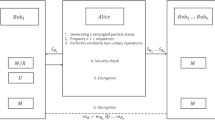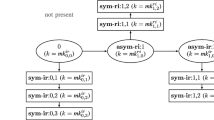Abstract
Efficient key establishment is an important problem for secure group communications. The communication and storage complexity of group key establishment problem has been studied extensively. In this paper, we propose a new group key establishment protocol whose computation complexity is significantly reduced. Instead of using classic secret sharing, the protocol only employs a linear secret sharing scheme, using Vandermonde Matrix, to distribute group key efficiently. This protocol drastically reduces the computation load of each group member and maintains at least the same security degree compared to existing schemes employing traditional secret sharing. The security strength of this scheme is evaluated in detail. Such a protocol is desirable for many wireless applications where portable devices or sensors need to reduce their computation as much as possible due to battery power limitations. This protocol provides much lower computation complexity while maintaining low and balanced communication complexity and storage complexity for secure group key establishment.
Similar content being viewed by others
References
Stinson, D. R. (1997). On some methods for unconditionally secure key distribution and broadcast encryption. Designs, Codes and Cryptography, 12, 215–243.
Stinson, D. R., & van Trung, T. (1998). Some new results on key distribution patterns and broadcast encryption. Designs, Codes and Cryptography, 14, 261–279.
Waldvogel, M., Caronni, G., Sun, D., Weiler, N., & Plattner, B. (1999). The VersaKey framework: Versatile group key management. IEEE Journal on Selected Areas in Communications, 7(8), 1614–1631.
Wallner, D., Harder, E., & Agee, R. (1999). Key management for multicast: Issues and architectures. RFC 2627.
Wong, C. K., Gouda, M., & Lam, S. S. (1998). Secure group communications using key graphs. In Proceedings of ACM SIGCOMM’98.
Mittra, S. (1997). Iolus: A framework for scalable secure multicasting. In Proceedings of ACM SIGCOMM’97 (pp. 277–288).
Rafaeli, S., & Hutchison, D. (2003). A survey of key management for secure group communication. ACM Computing Surveys, 35(3), 309–329.
Rodeh, O., Birman, K., & Dolev, D. (2001). The architecture and performance of security protocols in the ensemble group communication system. ACM Transactions on Information and System Security, 4(3), 289–319.
McEliece, R. J., & Sarwate, D. V. (1981). On sharing secrets and Reed–Solomon codes. Communications of the ACM, 26(9), 583–584.
Shamir, A. (1979). How to share a secret. Communications of the ACM, 24(11), 612–613.
Chou, G. H., & Chen, W. T. (1989). Secure broadcasting using the secure lock. IEEE Transactions on Software Engineering, 15(8), 929–934.
Fiat, A., & Naor, M. (1994). Broadcast encryption. In Advances in Cryptology—Proceedings of 13th Annual International Cryptology Conference (CRYPTO’94) (pp. 480–491).
Blundo, C., & Cresti, A. (1995). Space requirement for broadcast encryption. In Advances in Cryptology—Proceedings of Workshop Theory and Application of Cryptographic Techniques (EUROCRYPT’95) (pp. 287–298).
Blundo, C., De Santis, A., Herzberg, A., Kutten, S., Vaccaro, U., & Yung, M. (1993). Perfectly secure key distribution in dynamic conferences. In Advances in Cryptology—Proceedings of Workshop Theory and Application of Cryptographic Techniques (EUROCRYPT’93) (pp. 471–486).
Blundo, C., Frota Mattos, L. A., & Stinson, D. R. (1996). Trade-offs between communication and storage in unconditionally secure schemes for broadcast encryption and interactive key distribution. In Advances in Cryptology—Proceedings of 16th Annual International Cryptology Conference (CRYPTO’96) (pp. 387–400).
Luby, M., & Staddon, J. (1998). Combinatorial bounds for broadcast encryption. In Advances in Cryptology—Proceedings of International Conference Theory and Application of Cryptographic Techniques (EUROCRYPT’98) (pp. 512–526).
Sherman, A. T., & McGrew, D. A. (2003). Key establishment in large dynamic groups using one-way function trees. IEEE Transactions on Software Engineering, 29(5), 444–458.
Blakley, G. R. (1979). Safeguarding cryptographic keys. In Proceedings of American Federation of Information Processing Societies. (AFIPS’79) National Computer Conference (Vol. 48, pp. 313–317).
Laih, C., Lee, J., & Harn, L. (1989). A new threshold scheme and its application in designing the conference key distribution cryptosystem. Information Processing Letters, 32, 95–99.
Berkovits, S. (1991). How to broadcast a secret. In Proceedings of Eurocrypt’91 Workshop Advances in Cryptology (pp. 536–541).
Li, C. H., & Pieprzyk, J. (1999). Conference key agreement from secret sharing. In Proceedings of Fourth Australasian Conference Information Security and Privacy (ACISP’99) (pp. 64–76).
Saze, G. (2003). Generation of key predistribution schemes using secret sharing schemes. Discrete Applied Mathematics, 128, 239–249.
Harn, L., & Lin, C. (2010). Authenticated group key transfer protocol based on secret sharing. IEEE Transactions on Computers, 59(6), 842–846.
Hsu, Chingfang, Zeng, Bing, Cui, Guohua, & Chen, Liang. (2013). A new secure authenticated group key transfer protocol. Wireless Personal Communications. doi:10.1007/s11277-013-1298-2.
Hsu, Chingfang, Cheng, Qi, Tang, Xueming, & Zeng, Bing. (2011). An ideal multi-secret sharing scheme based on MSP. Information Sciences, 181(7), 1403–1409.
Beimel, A. (1996). Secure schemes for secret sharing and key distribution. Ph.D. Dissertation, Technion—Israel Institute of Technology Haifa, Israel.
Karchmer M., & Wigderson, A. (1993). On span programs. In Proceedings of 8th Annual Conference Structure in Complexity, San Diego, CA (pp. 102–111).
Hsu, C., Zeng, B., & Zhang, M. (2014). A novel group key transfer for big data security. Applied Mathematics and Computation, 249, 436–443.
Cho, J.-H., Chen, I.-R., & Eltoweissy, M. (2008). On optimal batch rekeying for secure group communications in wireless networks. Wireless Networks, 14(6), 915–927.
Choi, D., Choi, H.-K., & Lee, S.-Y. (2015). A group-based security protocol for machine-type communications in LTE-advanced. Wireless Networks, 21(2), 405–419.
Acknowledgments
This work was supported by the self-determined research funds of CCNU from the colleges’ basic research and operation of MOE, under Grant CCNU15ZD003 and CCNU15A02018, and the major Project of national social science fund, under Grant 12&2D223.
Author information
Authors and Affiliations
Corresponding author
Rights and permissions
About this article
Cite this article
Hsu, CF., Harn, L., Mu, Y. et al. Computation-efficient key establishment in wireless group communications. Wireless Netw 23, 289–297 (2017). https://doi.org/10.1007/s11276-016-1223-1
Published:
Issue Date:
DOI: https://doi.org/10.1007/s11276-016-1223-1




